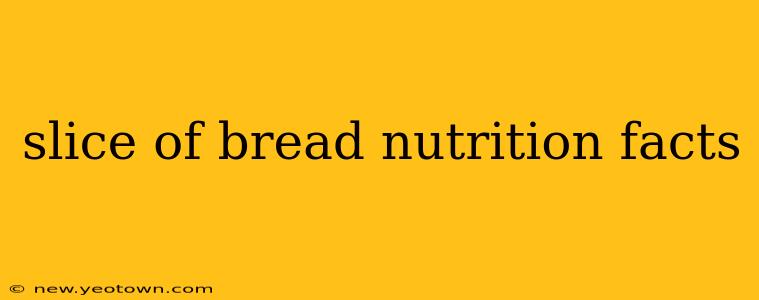Ah, the humble slice of bread. A staple in kitchens worldwide, a cornerstone of countless meals, and often overlooked in terms of its nutritional complexity. But beyond its simple appearance lies a surprisingly diverse nutritional profile, varying greatly depending on the type of bread. Let's delve into the fascinating world of bread nutrition, exploring the facts and dispelling some common myths.
What are the Basic Nutritional Facts of a Slice of Bread?
The nutritional content of a single slice of bread can fluctuate dramatically, depending on factors like the type of flour used (white, whole wheat, rye, etc.), added ingredients (sugars, oils, seeds), and the baking process. However, we can establish some general guidelines. A typical slice of white bread (around 1 ounce) often contains:
- Calories: Approximately 70-80 calories.
- Carbohydrates: Around 13-15 grams, primarily from starch.
- Protein: Around 2-3 grams.
- Fat: Usually less than 1 gram.
Keep in mind, these are just estimates. Always check the nutrition label on the specific bread you're consuming for the most accurate information.
What are the different types of bread and how does their nutritional value differ?
This is where things get interesting. The seemingly simple slice of bread opens up a world of nutritional diversity. Let's compare a few popular types:
-
White Bread: Generally lower in fiber and micronutrients compared to whole-wheat varieties. It offers a quicker energy boost due to its refined carbohydrates, but this can lead to blood sugar spikes.
-
Whole Wheat Bread: The nutritional champion! Packed with fiber, which aids digestion and promotes satiety. It's also a good source of various vitamins and minerals like iron and B vitamins. The fiber helps regulate blood sugar levels more effectively.
-
Rye Bread: Known for its distinct flavor and slightly higher fiber content than white bread, though often not as high as whole wheat. It can also boast a unique array of antioxidants.
-
Sourdough Bread: Often boasts better digestibility due to the fermentation process, which breaks down some of the complex carbohydrates. The nutritional profile can vary widely depending on the ingredients used.
Does bread have any health benefits?
Beyond simply providing energy, bread, especially whole-grain varieties, offers several potential health benefits:
-
Fiber: Crucial for digestive health, preventing constipation and promoting a healthy gut microbiome. High-fiber bread can also contribute to feelings of fullness, aiding in weight management.
-
B Vitamins: Essential for energy production, nerve function, and red blood cell formation. Whole-grain breads are often good sources of these vitamins.
-
Iron: Important for oxygen transport throughout the body. Some enriched breads provide a good source of iron.
Is bread bad for weight loss?
The relationship between bread and weight loss is complex and often misunderstood. Refined-grain breads (like white bread) are often higher in simple carbohydrates, which can lead to blood sugar spikes and cravings. Conversely, whole-grain breads, with their higher fiber content, can promote satiety, potentially helping with weight management. Moderation and mindful consumption are key, regardless of the type of bread.
Is bread good for diabetics?
For individuals with diabetes, choosing the right type of bread is crucial. Whole-grain breads, with their slower release of glucose into the bloodstream, are generally preferred over refined-grain options. Always monitor blood sugar levels after consuming bread and adjust your portion sizes accordingly. Consulting a doctor or registered dietitian is recommended for personalized dietary advice.
What are some healthy alternatives to bread?
While bread can be a healthy part of a balanced diet, exploring alternatives can diversify your culinary experiences and nutritional intake. These could include:
- Whole-grain crackers: Often lower in calories and offer similar fiber benefits to whole-grain bread.
- Sweet potatoes: A naturally sweet and nutritious alternative, rich in vitamins and fiber.
- Lettuce wraps: A low-calorie option for sandwiches and wraps.
The next time you reach for a slice of bread, remember the nutritional nuances hidden within. Choosing wisely, understanding the different varieties and their impact on your health, allows you to enjoy this culinary staple as part of a balanced and fulfilling diet.

